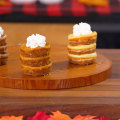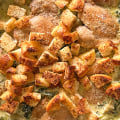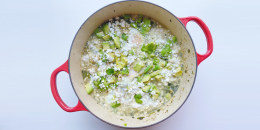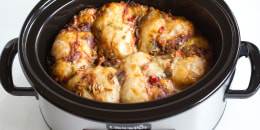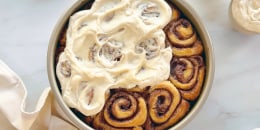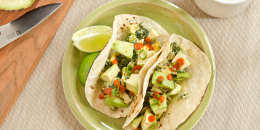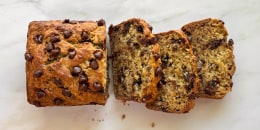Chef notes
Sitting in my mother Callie White’s kitchen and watching her prepare pans of these highly sought-after, melt-in-your mouth bites of goodness for her catering business gave me the lightning bolt of inspiration to start Callie’s Charleston Biscuits.
The beauty of this recipe is that biscuit making can be part of any family tradition. Just save it for a day when a little bit of a mess in the kitchen won’t derail the rest of your plans, because this dough is wet and sticky. If the dough gobs between your fingers with the consistency of pluff mud (what we in the South call marsh mud), don’t worry ... that’s a good sign!
Ingredients
- 2 cups self-rising flour (White Lily preferred), plus more for dusting
- 5 tablespoons butter (4 tablespoons cut in small cubes, at room temperature, and 1 tablespoon melted)
- 1/4 cup cream cheese, at room temperature
- 3/4 cup whole buttermilk
Preparation
1.Preheat the oven to 500 degrees. Make sure the oven rack is in the middle position.
2.Measure the flour into a large bowl. Incorporate the cubed butter, then the cream cheese into the flour, using your fingers to “cut in” the butter and cheese until the mixture resembles cottage cheese. It will be chunky with some loose flour.
3.Make a well in the center. Pour in the buttermilk and, using your hands or a small rubber spatula, mix the flour into the buttermilk. The dough will be wet and messy.
4.Sprinkle flour on top of the dough. Run a rubber spatula around the inside of the bowl, creating a separation between the dough and the bowl. Sprinkle a bit more flour in this crease.
5.Flour a work surface or flexible baking mat very well. With force, dump the dough from the bowl onto the surface. Flour the top of the dough and the rolling pin. Roll out the dough to 1-inch thickness into an oval shape. (No kneading is necessary — the less you mess with the dough, the better.)
6.Flour a 2-inch round metal biscuit cutter or biscuit glass. Start from the edge of the rolled-out dough and cut straight through the dough with the cutter, trying to maximize the number of biscuits cut from this first roll out. Roll out the excess dough after the biscuits are cut and cut more biscuits. As long as the dough stays wet inside, you can use as much flour on the outside as you need to handle the dough.
7.Place the biscuits on a baking sheet with sides lined with parchment paper, or in a cast-iron skillet, or a baking pan with the biscuit sides touching. (It does not matter what size pan or skillet you use as long as the pan has a lip or sides and the biscuits are touching. If you are using a cast iron skillet, no parchment paper is necessary.) Brush the tops with the melted butter.
8.Place the pan in the oven and immediately reduce the temperature to 450 degrees. Bake 16 to 18 minutes until light brown on top (or as dark as you prefer) and rotate the pan once while baking.



